
In the history of Poland, a royal city or royal town (Polish: miasto królewskie) was an urban settlement within the crown lands (Polish: królewszczyzna).
The most influential royal cities enjoyed voting rights during the free election period in Poland (1572–1791). These cities were Gdańsk, Warsaw, Kraków, Poznań, Lwów, Wilno, Toruń, Lublin, Kamieniec and Elbląg. Other important royal cities included Gniezno (ecclesiastical capital of Poland and former capital of early medieval Poland), Płock (former capital of medieval Poland), Piotrków (second most important political center of Poland in the early and mid-16th century as the main location of the Sejm, and then the main Crown Tribunal location alongside Lublin, thus one of the two judiciary capitals of Poland), Grodno (de facto capital of the Polish–Lithuanian Commonwealth in the 1580s and then the general sejm location alongside Warsaw), Bydgoszcz and Kalisz (temporary locations of the Crown Tribunal), and Sandomierz, Przemyśl, Kazimierz.
Law on the Cities
Main article: Free Royal Cities ActOn April 18, 1791, the Great Sejm adopted the Free Royal Cities Act (full title: "Miasta nasze królewskie wolne w państwach Rzeczypospolitej" - "Our Free Royal Cities in the States of the Commonwealth"), included as Article III into the Constitution of May 3, 1791.
The law granted a number of privileges for the residents of royal cities. Many of these privileges and rights have already been enjoyed by major royal cities, and the law effectively equalized all royal cities in this respect. It also includes some rights earlier enjoyed only by szlachta.
Royal cities by region
Crown of the Kingdom of Poland
Greater Poland Province
 Warsaw in the 18th century
Warsaw in the 18th century Gdańsk in the 16th century
Gdańsk in the 16th century Poznań in the 17th century
Poznań in the 17th century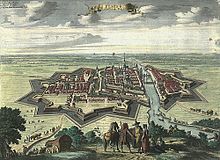 Elbląg in the 18th century
Elbląg in the 18th century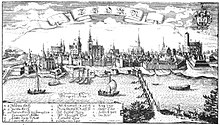 Toruń in the 17th century
Toruń in the 17th century Piotrków in the 17th century
Piotrków in the 17th century Grudziądz in the 17th century
Grudziądz in the 17th century Brześć Kujawski in the 17th century
Brześć Kujawski in the 17th century Sztum in the 18th century
Sztum in the 18th century
- Babimost
- Biały Bór
- Bielsk
- Błonie
- Bobrowniki
- Bolesławiec
- Bolimów
- Brdów
- Brodnica
- Brójce
- Brześć Kujawski
- Budziszewice
- Budzyń
- Bydgoszcz
- Chojnice
- Chorzele
- Ciechanów
- Czaplinek
- Czarne
- Czersk
- Człopa
- Człuchów
- Dąbie
- Dąbrowice
- Debrzno
- Dobrzyń nad Wisłą
- Dzierzgoń
- Elbląg
- Fordon
- Garwolin
- Gąbin
- Gdańsk
- Gębice
- Gniezno
- Gniew
- Gniewkowo
- Golub
- Gostynin
- Goszczyn
- Grabów nad Prosną
- Grójec
- Grudziądz
- Inowłódz
- Inowrocław
- Janowo
- Kalisz
- Kamieńczyk
- Kamion
- Kampinos
- Kcynia
- Kłecko
- Kłodawa
- Kolno
- Koło
- Konin
- Kopanica
- Kościan
- Kościerzyna
- Kowal
- Kowalewo Pomorskie
- Kruszwica
- Latowicz
- Lidzbark
- Lipno
- Liw
- Łasin
- Łęczyca
- Łomża
- Maków Mazowiecki
- Malbork
- Mieścisko
- Międzyrzecz
- Mikstat
- Mława
- Mosina
- Mszczonów
- Nakło nad Notecią
- Nieszawa
- Nowa Brzeźnica
- Nowe
- Nowe Miasto, Płońsk County
- Nowe Miasto Lubawskie
- Nowogród
- Nur
- Oborniki
- Odolanów
- Osieck
- Osmolin
- Ostrołęka
- Ostrów
- Ostrzeszów
- Pajęczno
- Piaseczno
- Piła
- Piotrków
- Płock
- Płońsk
- Pobiedziska
- Podgórz
- Powidz
- Poznań
- Przasnysz
- Przedecz
- Puck
- Pyzdry
- Radomsko
- Radziejów
- Radziłów
- Radzyń
- Rawa
- Rogoźno
- Różan
- Rypin
- Serock
- Sieradz
- Skarszewy
- Skulsk
- Skwierzyna
- Sochaczew
- Sochocin
- Solec
- Stanisławów
- Starogard
- Stawiszyn
- Sulmierzyce
- Szadek
- Szczerców
- Sztum
- Śrem
- Środa
- Świecie
- Tczew
- Tolkmicko
- Toruń
- Tuchola
- Tuszyn
- Ujście
- Wałcz
- Warka
- Warsaw
- Warsaw New Town
- Warta
- Wąsosz
- Wieluń
- Wiskitki
- Wizna
- Wschowa
- Wyszogród
- Zakroczym
- Zambrów
- Zgierz
Lesser Poland Province
 Kraków, Kleparz and Kazimierz in the 17th century - agglomeration of three royal cities
Kraków, Kleparz and Kazimierz in the 17th century - agglomeration of three royal cities Lwów in the 17th century
Lwów in the 17th century Lublin in the 17th century
Lublin in the 17th century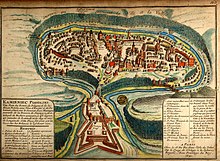 Kamieniec Podolski in the 17th century
Kamieniec Podolski in the 17th century Przemyśl in the 17th century
Przemyśl in the 17th century Sandomierz in the 17th century
Sandomierz in the 17th century Chełm in the 17th century
Chełm in the 17th century Biecz in the 17th century
Biecz in the 17th century Łuck in the 18th century
Łuck in the 18th century
- Augustów
- Bar (today part of Ukraine)
- Bełz (today part of Ukraine)
- Berezań (today part of Ukraine)
- Będzin
- Bila Tserkva (today part of Ukraine)
- Biecz
- Bielsk
- Bobrovytsia (today part of Ukraine)
- Bohuslav (today part of Ukraine)
- Bracław (today part of Ukraine)
- Brańsk
- Busk (today part of Ukraine)
- Chełm
- Chęciny
- Chmielnik
- Chmielnik (today part of Ukraine)
- Chyhyryn (today part of Ukraine)
- Czerkasy (today part of Ukraine)
- Chervonohorod (today part of Ukraine)
- Częstochowa
- Dobrotvir (today part of Ukraine)
- Drohiczyn
- Dubienka
- Goniądz
- Grabowiec
- Grybów
- Haisyn (today part of Ukraine)
- Horodło
- Yahotyn (today part of Ukraine)
- Yaltushkiv (today part of Ukraine)
- Kamieniec Podolski (today part of Ukraine)
- Kaniv (today part of Ukraine)
- Kazimierz
- Kazimierz Dolny
- Kęty
- Kijów (today part of Ukraine)
- Kleparz
- Kleszczele
- Kłobuck
- Knyszyn
- Korsuń (today part of Ukraine)
- Koszyce
- Kowel (today part of Ukraine)
- Kozienice
- Kraków
- Krasnystaw
- Kremenets (today part of Ukraine)
- Krzepice
- Lanckorona
- Letychiv (today part of Ukraine)
- Lelów
- Leżajsk
- Lityn (today part of Ukraine)
- Lubaczów
- Liubech (today part of Ukraine)
- Lublin
- Luboml (today part of Ukraine)
- Lwów (today part of Ukraine)
- Łosice
- Łuck (today part of Ukraine)
- Łuków
- Małogoszcz
- Mielnik
- Mościska (today part of Ukraine)
- Mylianovychi (today part of Ukraine)
- Myrhorod (today part of Ukraine)
- Narew
- Nova Ushytsia (today part of Ukraine)
- Nowy Korczyn
- Nowy Sącz
- Nowy Targ
- Olkusz
- Olsztyn
- Opoczno
- Osiek
- Oster (today part of Ukraine)
- Oświęcim
- Ovruch (today part of Ukraine)
- Parczew
- Pereiaslav (today part of Ukraine)
- Pierzchnica
- Pilzno
- Piwniczna
- Podgórze
- Połaniec
- Potelych (today part of Ukraine)
- Płoskirów (today part of Ukraine)
- Proszowice
- Przedbórz
- Przemyśl
- Radom
- Radoszyce
- Rajgród
- Ratno (today part of Ukraine)
- Rohatyn (today part of Ukraine)
- Ropczyce
- Ryczywół
- Sambor (today part of Ukraine)
- Sandomierz
- Sanok
- Szczurowice (today part of Ukraine)
- Słomniki
- Smotrycz (today part of Ukraine)
- Sokal (today part of Ukraine)
- Solec nad Wisłą
- Stebliv (today part of Ukraine)
- Stężyca
- Stopnica
- Stoianiv (today part of Ukraine)
- Stary Sambor (today part of Ukraine)
- Stryj (today part of Ukraine)
- Suraż
- Świniuchy (today part of Ukraine)
- Szydłów
- Trakhtemyriv (today part of Ukraine)
- Tykocin
- Tymbark
- Tyszowce
- Ulaniv (today part of Ukraine)
- Urzędów
- Uście Solne
- Velyki Mosty (today part of Ukraine)
- Vinnytsia (today part of Ukraine)
- Vyshnivka (today part of Ukraine)
- Wąwolnica
- Wieliczka
- Wiślica
- Włodzimierz (today part of Ukraine)
- Wolbrom
- Zbuczyn
- Zvenyhorodka (today part of Ukraine)
- Zwoleń
- Żydaczów (today part of Ukraine)
- Żytomierz (today part of Ukraine)
Grand Duchy of Lithuania
 Vilnius in the 17th century
Vilnius in the 17th century Grodno in the 16th century
Grodno in the 16th century Kaunas in the 17th century
Kaunas in the 17th century Brest in the 17th century
Brest in the 17th century Mogilev in the 18th century
Mogilev in the 18th century Trakai in the 17th century
Trakai in the 17th century
- Adelsk (today part of Belarus)
- Astryna (today part of Belarus)
- Azarychy (today part of Belarus)
- Azyory (today part of Belarus)
- Berżniki (today part of Poland)
- Babruysk (today part of Belarus)
- Braslaw (today part of Belarus)
- Brest (today part of Belarus)
- Chachersk (today part of Belarus)
- Chavusy (today part of Belarus)
- Cherykaw (today part of Belarus)
- Druskininkai (today part of Lithuania)
- Drysa (today part of Belarus)
- Drysvyaty (today part of Belarus)
- Dyvin (today part of Belarus)
- Dzisna (today part of Belarus)
- Eišiškės (today part of Lithuania)
- Filipów (today part of Poland)
- Gomel (today part of Belarus)
- Grodno (today part of Belarus)
- Haradnaya (today part of Belarus)
- Hieraniony (today part of Belarus)
- Hozha (today part of Belarus)
- Jałówka (today part of Poland)
- Janów (today part of Poland)
- Jeleniewo (today part of Poland)
- Jurbarkas (today part of Lithuania)
- Kalinkavichy (today part of Belarus)
- Kamyenyets (today part of Belarus)
- Kaunas (today part of Lithuania)
- Khotsimsk (today part of Belarus)
- Kletsk (today part of Belarus)
- Klichaw (today part of Belarus)
- Kobryn (today part of Belarus)
- Korycin (today part of Poland)
- Krasnapolle (today part of Belarus)
- Krasnopol (today part of Poland)
- Krynki (today part of Poland)
- Krychaw (today part of Belarus)
- Lahishyn (today part of Belarus)
- Lazdijai (today part of Lithuania)
- Lida (today part of Belarus)
- Lipnishki (today part of Belarus)
- Lunna (today part of Belarus)
- Łomazy (today part of Poland)
- Malyech (today part of Belarus)
- Masty (today part of Belarus)
- Mazyr (today part of Belarus)
- Milejczyce (today part of Poland)
- Minsk (today part of Belarus)
- Mogilev (today part of Belarus)
- Motal (today part of Belarus)
- Mstsibava (today part of Belarus)
- Mstsislaw (today part of Belarus)
- Myadzyel (today part of Belarus)
- Novy Dvor (today part of Belarus)
- Opsa (today part of Belarus)
- Orsha (today part of Belarus)
- Parychy (today part of Belarus)
- Pinsk (today part of Belarus)
- Piszczac (today part of Poland)
- Polotsk (today part of Belarus)
- Porazava (today part of Belarus)
- Prapoysk (today part of Belarus)
- Pruzhany (today part of Belarus)
- Przerośl (today part of Poland)
- Pyerabroddzye (today part of Belarus)
- Pryvalki (today part of Belarus)
- Radashkovichy (today part of Belarus)
- Radun (today part of Belarus)
- Rahachow (today part of Belarus)
- Rechytsa (today part of Belarus)
- Sharashova (today part of Belarus)
- Skidzyel’ (today part of Belarus)
- Sokółka (today part of Poland)
- Suchowola (today part of Poland)
- Suraż (today part of Belarus)
- Szczebra (today part of Poland)
- Šventoji (today part of Lithuania)
- Traby (today part of Belarus)
- Trakai (today part of Lithuania)
- Usvyaty (today part of Russia)
- Vasilishki (today part of Belarus)
- Vawkavysk (today part of Belarus)
- Velizh (today part of Russia)
- Vilnias (today part of Lithuania)
- Virbalis (today part of Lithuania)
- Vištytis (today part of Lithuania)
- Vitebsk (today part of Belarus)
- Vladislavovas (today part of Lithuania)
- Voŭpa (today part of Belarus)
- Wasilków (today part of Poland)
- Wiżajny (today part of Poland)
- Wohyń (today part of Poland)
Royal castles and residences
Examples of Polish royal castles and residences found in former royal cities of Poland:
-
 Wawel Castle, Kraków (World Heritage Site)
Wawel Castle, Kraków (World Heritage Site)
-
Royal Castle, Warsaw (World Heritage Site)
-
 Royal Castle, Malbork (World Heritage Site)
Royal Castle, Malbork (World Heritage Site)
-
Royal Castle, Lublin
-
 Royal Castle, Sandomierz
Royal Castle, Sandomierz
-
 Royal Castle, Łęczyca
Royal Castle, Łęczyca
-
Royal Castle, Będzin
-
 Royal Castle, Sanok
Royal Castle, Sanok
-
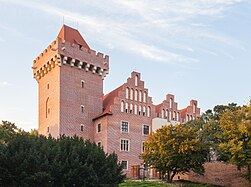 Royal Castle, Poznań
Royal Castle, Poznań
-
Royal Castle, Tykocin
-
 Remainings of the Royal Castle, Nowy Sącz
Remainings of the Royal Castle, Nowy Sącz
-
 Remainings of the Royal Castle, Olsztyn
Remainings of the Royal Castle, Olsztyn
-
 Remainings of the Royal Castle, Kremenets
Remainings of the Royal Castle, Kremenets
-
 Royal Castle, Piotrków Trybunalski
Royal Castle, Piotrków Trybunalski
-
 Old Grodno Castle
Old Grodno Castle
-
 Green Gate, Gdańsk
Green Gate, Gdańsk
Old towns
The historic old towns of Kraków, Warsaw, Toruń, Vilnius and Lviv are designated UNESCO World Heritage Sites, and additionally the old towns of Gdańsk, Kazimierz Dolny, Lublin, Przemyśl, Sandomierz and Tykocin are designated Historic Monuments of Poland. Examples of Polish royal cities historic centers include:
-
 Kraków Old Town (World Heritage Site)
Kraków Old Town (World Heritage Site)
-
 Warsaw Old Town (World Heritage Site)
Warsaw Old Town (World Heritage Site)
-
 Medieval Town of Toruń (World Heritage Site)
Medieval Town of Toruń (World Heritage Site)
-
 Vilnius Old Town (World Heritage Site)
Vilnius Old Town (World Heritage Site)
-
 Lviv Old Town (World Heritage Site)
Lviv Old Town (World Heritage Site)
-
 Poznań Old Town
Poznań Old Town
-
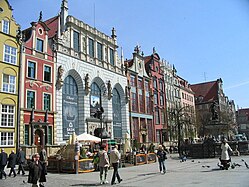 Gdańsk Main City
Gdańsk Main City
-
Lublin Old Town
-
 Bydgoszcz Old Town
Bydgoszcz Old Town
-
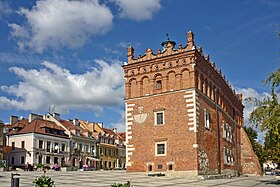 Sandomierz Old Town
Sandomierz Old Town
-
 Grudziądz Old Town
Grudziądz Old Town
-
 Przemyśl Old Town
Przemyśl Old Town
-
 Kazimierz Dolny Old Town
Kazimierz Dolny Old Town
-
 Grodno Old Town
Grodno Old Town
-
 Kaunas Old Town
Kaunas Old Town
See also
References
- "Miasto królewskie, książęce, biskupie itp. – Słownik języka polskiego PWN".
- Polska encyklopedja szlachecka, Tom I (in Polish). Warszawa: Wydawnictwo Instytutu Kultury Historycznej. 1935. p. 42.
- Marozau, Siarhei (2020). "Stefan Batory w pamięci historycznej Grodna i jego mieszkańców (XX – początek XXI wieku)". Studia Białorutenistyczne. 14. Lublin: Wydawnictwo Uniwersytetu Marii Curie-Skłodowskiej: 90. ISSN 1898-0457.
- Rutkowski, Henryk (1978). "Trybunał Koronny (1578—1794)". Palestra (22/10). Lublin: 7, 15.
- Balzer, Oswald (1886). Geneza Trybunału Koronnego: studyum z dziejów sądownictwa polskiego XVI wieku (in Polish). Warsaw: Biblioteka Umiejętności Prawnych. p. 208.
- ^ Atlas historyczny Polski. Wielkopolska w drugiej połowie XVI wieku. Część I. Mapy, plany (in Polish). Warszawa: Instytut Historii Polskiej Akademii Nauk. 2017. p. 1a.
- ^ Mazowsze w drugiej połowie XVI wieku; Cz.1, Mapy, plany (in Polish). Warszawa: Wydawnictwo Naukowe PWN. pp. 3–4.
- ^ Atlas historyczny Polski. Kujawy i ziemia dobrzyńska w drugiej połowie XVI wieku. Część I. Mapy, plany (in Polish). Warszawa: Instytut Historii Polskiej Akademii Nauk. 2021. p. 1.
- ^ Atlas historyczny Polski. Województwo sieradzkie i województwo łęczyckie w drugiej połowie XVI wieku. Część I. Mapy, plany (in Polish). Warszawa: Instytut Historii Polskiej Akademii Nauk. 1998. pp. 3–4.
- ^ Atlas historyczny Polski. Wielkopolska w drugiej połowie XVI wieku. Część I. Mapy, plany (in Polish). Warszawa: Instytut Historii Polskiej Akademii Nauk. 2017. p. 1b.
- ^ Atlas historyczny Polski. Województwo podlaskie w drugiej połowie XVI wieku. Część I. Mapy, plany (in Polish). Warszawa: Instytut Historii Polskiej Akademii Nauk. 2021. p. 1.
- ^ Województwo sandomierskie w drugiej połowie XVI wieku; Cz.1, Mapy, plany (in Polish). Warszawa: Wydawnictwo Naukowe PWN. 1993. pp. 3–4.
- Słownik geograficzny Królestwa Polskiego i innych krajów słowiańskich, Tom IX (in Polish). Warszawa. 1888. p. 439.
{{cite book}}: CS1 maint: location missing publisher (link) - Zarządzenie Prezydenta Rzeczypospolitej Polskiej z dnia 8 września 1994 r. w sprawie uznania za pomnik historii., M.P., 1994, vol. 50, No. 415
- Rozporządzenie Prezydenta Rzeczypospolitej Polskiej z dnia 25 kwietnia 2007 r. w sprawie uznania za pomnik historii "Lublin - historyczny zespół architektoniczno-urbanistyczny", Dz. U., 2007, vol. 86, No. 574
- Rozporządzenie Prezydenta Rzeczypospolitej Polskiej z dnia 10 grudnia 2018 r. w sprawie uznania za pomnik historii "Przemyśl - zespół staromiejski", Dz. U., 2018, No. 2419
- Rozporządzenie Prezydenta Rzeczypospolitej Polskiej z dnia 22 listopada 2017 r. w sprawie uznania za pomnik historii "Sandomierz - historyczny zespół architektoniczno-krajobrazowy", Dz. U., 2017, No. 2273
- Rozporządzenie Prezydenta Rzeczypospolitej Polskiej z dnia 19 kwietnia 2021 r. w sprawie uznania za pomnik historii "Tykocin - historyczny zespół miasta", Dz. U., 2021, No. 768